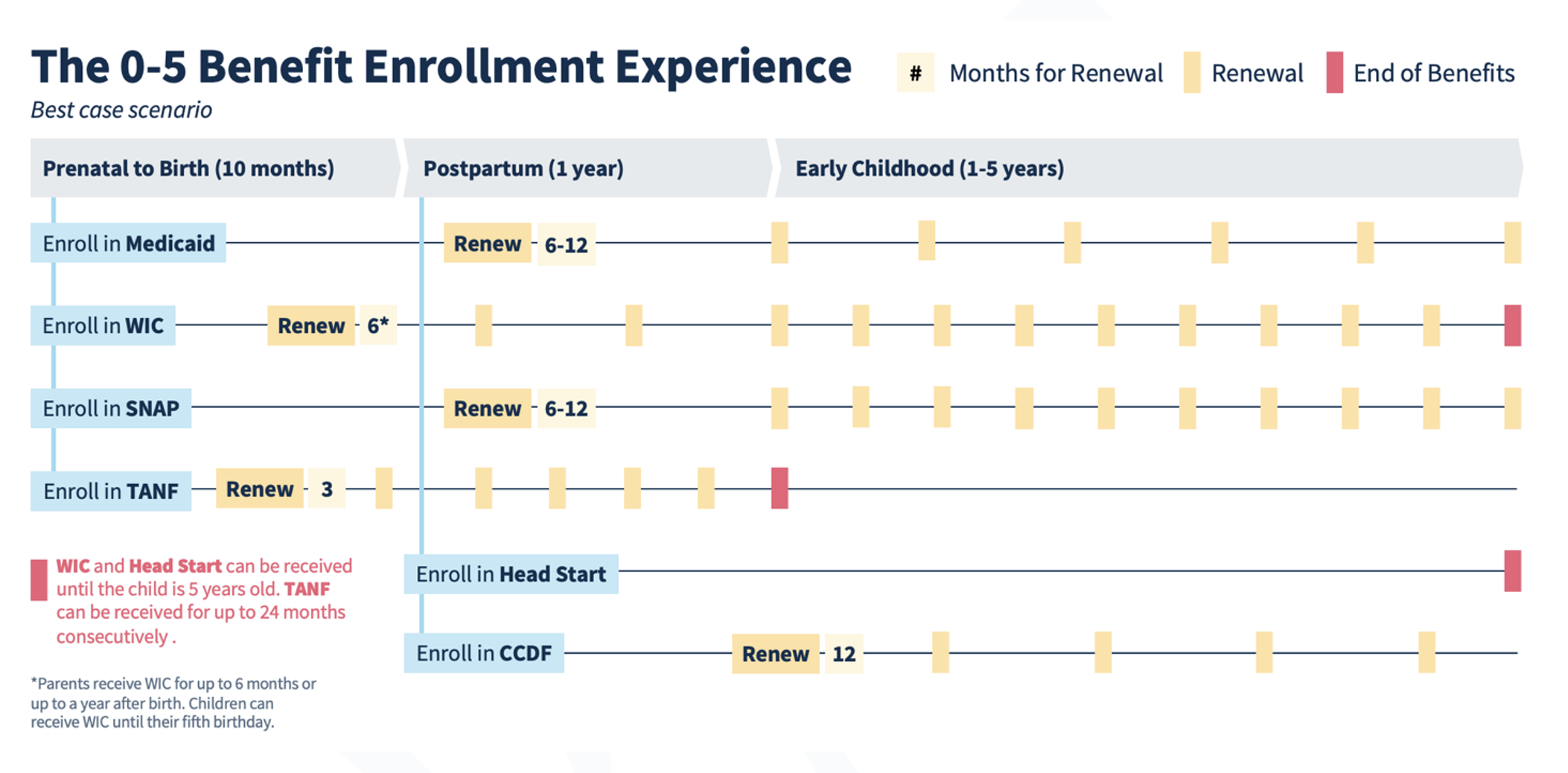Why We’re Designing Government to Work Better and Smarter for Families
By Maya Uppaluru Mechenbier, Allison Abbott, Alex Bornkessel, Alana Buroff, Phoebe Brauer
PMA life experiences
This is a guest post from our colleagues at the U.S. Digital Service to highlight their work on the Having a Child and Early Childhood Life Experience.
For any parent, carrying and delivering a child is one of the most life changing experiences they will go through. And yet, the stresses and burdens are more difficult for low-income families. Too often, parents have to navigate a tangled web of government websites, offices, and phone numbers to access the services they are eligible to receive. Our team spent the last year speaking with families nationwide about this moment in their lives, to better understand where government services could better support them. We’ve now launched three projects to directly address the feedback we heard. This blog post is part of a series we’ll be sharing throughout 2023 tracking our projects’ progress, learnings, and results.
In December 2021, President Biden’s Executive Order on Transforming Federal Customer Experience and Service Delivery to Rebuild Trust in Government emphasized a customer-centric approach focused on understanding individuals’ needs during significant life experiences—such as the birth of a child. By adopting a “Life Experiences” framework, the government aims to improve accessibility and responsiveness, ensuring services meet people where they are and simplify their journeys.

Understanding the Journey: Collaborative Insights into Supporting Families from Pregnancy to Age Five
The challenges parents face after having a child can be overwhelming. Access to essential resources such as healthcare, nutritious food, housing, transportation, and affordable child care are crucial for the well-being of families. However, the reality is that too many American families are constantly in survival mode.
The reality is that too many American families are constantly in survival mode
Our multidisciplinary, multi-agency team, including leadership from the U.S. Digital Service (USDS), set out to understand families’ experiences with federally-funded support as they go through the journey of welcoming a new baby to their household. In this process, we collaborated with over 120 families, community leaders, and numerous experts with extensive experience in managing family support programs to gain valuable insights into the root causes of the financial struggles faced by parents with young children. Beginning the discovery phase, we already knew that:
- Mothers experience a partial loss of income following birth, significantly impacting their households — the absence of paid leave and the growing expenses worsen the situation.
- Over 5 million children live in poverty during crucial developmental stages, with Black and Hispanic households disproportionately affected.
- Particularly during the pandemic, mothers have borne the weight of domestic violence, job loss, and limited access to child care options.
Despite government programs in place, approximately $60 billion in benefits intended for eligible families in need remains unused. Story after story, and expert after expert, confirm a troubling reality: the complex and fragmented system of services presents an insurmountable challenge for families to navigate. Improving access to the safety net will contribute to a continuing post-pandemic economic recovery for working families and their communities, and improve families’ health and well-being, as emphasized in the 2022 White House Blueprint for Addressing the Maternal Health Crisis.
Helping Families Navigate the 0–5 Benefit Enrollment Experience
Our team is working to simplify the benefit enrollment experience for new mothers and caregivers. As part of our research, we learned that parents are on their own without an authoritative, clear roadmap on how to navigate government support. This leaves parents in a maze of complex information, duplicative requests for documentation, waiting lists, hour-long phone calls, and administrative hoops—where, any missed deadline or forgotten requirement, could result in a family not receiving resources to meet their basic needs.
Some critical supports for young families include:
- Medicaid: Provides health coverage to people with limited income and resources.
- Special Supplemental Nutrition Program for Women, Infants, and Children (WIC): Provides supplemental foods, health care referrals, and nutrition education for low-income pregnant, breastfeeding, and non-breastfeeding postpartum women and to infants and children up to age five who are found to be at nutritional risk. Historically, WIC accounts for over half of U.S. formula consumption.
- Supplemental Nutrition Assistance Program (SNAP): Provides nutrition benefits to supplement the food budget of needy families so they can purchase healthy food.
- Temporary Assistance for Needy Families (TANF): Provides states and territories with flexibility in operating programs designed to help low-income families with children achieve economic self-sufficiency. TANF dollars fund monthly cash assistance payments to low-income families with children and other services.
- Child Care and Development Fund (CCDF): Provides financial assistance to low-income families to access child care so they can work or attend a job training or educational program.
- Housing vouchers: Assists low-income families, the elderly, and the disabled to afford decent, safe, and sanitary housing in the private market.
Having identified which federal programs young families use most frequently, we created a composite diagram that mapped enrollment timelines for the pregnancy and early childhood journeys based on examples from four states.

This task map makes it clear how daunting figuring out and managing these workstreams are for overworked, under-resourced parents. The systems that are supposed to support families during this life experience may in fact be causing more stress than their perceived worth by the family. This is especially difficult for eligible families with limited English proficiency, those who need transportation or child care, or those who cannot take time off work. Further, eligible families seeking assistance often must submit the same information over and over when they apply for each program individually, and navigate slightly different requirements for each program.
When we spoke to parents, they shared that they hold all of these programs’ application and renewal requirements in their heads, keeping tabs on information coming from various communications—that may or may not reach them or be easy to understand.
Research demonstrates a possible connection between administrative burdens when applying for programs and increased anxiety and psychological harm. Parents’ stress and mental health can directly impact family well-being and children’s emotional and social development. By improving access to these systems, we can contribute to the post-pandemic economic recovery of working families and their communities, while enhancing their overall health and well-being – a cornerstone priority of this Administration.
Advancing Maternal and Child Health: Collaborating for Innovative Government Services
To alleviate these burdens, we must streamline families’ support systems. By reducing redundancy, ensuring clear communication, and minimizing barriers, we can foster an environment where families can access the assistance they need without undue stress and anxiety. Our team’s work continues to drive better, more innovative government services for moms, families, and children. And it isn’t — nor can it be — done alone.
We are working alongside federal, state, and local partners as well as external organizations with decades of expertise in advancing maternal and child health to help elevate and amplify promising practices while continuing to center families and their experiences at the center of how we administer government programs and supports.
Visit Having a Child and Early Childhood Life Experience page to explore the full portfolio of work, including the findings from our research, journey maps, customer stories, and common pain points.
If you’d like to work on projects like this, consider joining USDS! We’re hiring mission-driven engineers, product managers, designers, bureaucracy hackers, procurement specialists, and operations experts who want to make an impact on the lives of their fellow Americans.
Have a practice or story to share? Send it to usds@omb.eop.gov.
